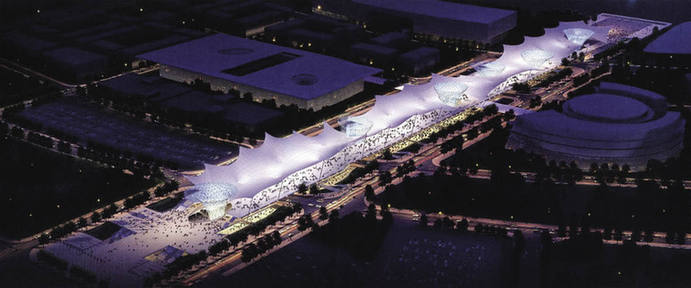|
Characteristic Foreign Pavilions
 |
|
The World Expo Axis. |
In general, foreign pavilions are temporary. They fall into three types. First, there are self-built pavilions, created by participating countries. There are about 40 such pavilions. Second are the rented pavilions, built by the host country for participating countries to rent. Third are the joint pavilions. Some African countries, for example, hold that it is unnecessary to build an independent pavilion, so the host country has built an African Pavilion to jointly hold 45 African countries. These joint pavilions are also rented. Zhu Yonglei says, “We have been meticulous in the design and construction of the African Pavilion, and have adopted many African elements. Since African friends are good at singing and dancing, we have built an African Square for them.”
Zhu Yonglei admits that the investment in self-built pavilions is large. Every pavilion has its own characteristics. At present, the design plans for nearly 20 pavilions have been published, and construction has started one after another.
To choose the best plan, in 2007 Britain sent six groups to do an on-the-spot investigation in Shanghai. Back home, they put forward six plans and exhibited them in Shanghai for local inhabitants to vote on. After that, they selected the final plan according to related procedures. The exterior wall of the British Pavilion is covered by 60,000 optical fibers that can show different colors and form many different patterns, and these fibers can wave in the wind.
The architects of the Luxembourg (called lu sen bao in Chinese) Pavilion also conducted an investigation in Shanghai before construction started. In Chinese “sen” means forest and “bao” means castle; in combination Lusenbao means a “castle in a forest.” In the eyes of Chinese people, Luxembourg is a small country. Therefore, the Luxembourg Pavilion is in the shape of a castle, and on it are carved four Chinese characters xiao ye shi mei, which means “small is beautiful too.”
The design plans for the Spanish Pavilion were solicited from women architects. The final plan is in the shape of a Flamenco skirt hem. It is woven from rattan, which can regulate the temperature and is environmentally friendly.
All the temporary pavilions must be dismantled after the 184-day exhibition period, so many advanced technologies have been employed. Various countries have used environmentally friendly technologies and materials, which can be recycled or are degradable. For instance, the outer wall of the Swiss Pavilion will be made of bean fibers, which can be used in power generation. A wall covered with biological paint is degradable.
According to Zhu Yonglei, after the temporary pavilions are dismantled, the land will not be used for real estate development. It will be turned into a new cultural, leisure and business center.
| 